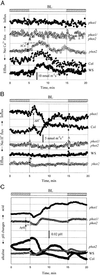Blue light-induced kinetics of H+ and Ca2+ fluxes in etiolated wild-type and phototropin-mutant Arabidopsis seedlings
- PMID: 11854534
- PMCID: PMC122382
- DOI: 10.1073/pnas.042294599
Blue light-induced kinetics of H+ and Ca2+ fluxes in etiolated wild-type and phototropin-mutant Arabidopsis seedlings
Abstract
Ion flux kinetics associated with blue light (BL) treatment of two wild types (WTs) and the phot1, phot2 and phot1/phot2 mutants of Arabidopsis were studied by using the MIFE noninvasive ion-selective microelectrode technique. BL induced significant changes in activity of H(+) and Ca(2+) transporters within the first 10 min of BL onset, peaking between 3 and 5 min. In all WT plants and in phot2 mutants, BL induced immediate Ca(2+) influx. In phot1 and phot1/phot2 mutants, net Ca(2+) flux remained steady. It is suggested that PHOT1 regulates Ca(2+) uptake into the cytoplasm from the apoplast. Changes in ion fluxes were measured from cotyledons of intact seedlings and from the cut top of the hypocotyl of decapitated seedlings. Thus the photoreceptors mediating BL-induced Ca(2+) and H(+) fluxes are present in the rest of the decapitated seedling and probably in the cotyledons as well. The H(+) and Ca(2+) flux responses to BL appear not to be linked because, (i) when changes were observed for both ions, Ca(2+) flux changed almost immediately, whereas H(+) flux lagged by about 1.5 min; (ii) in the Wassilewskija ecotype, changes in H(+) fluxes were small. Finally, wave-like changes in Ca(2+) and H(+) concentrations were observed along the cotyledon-hook axis regardless of its orientation to the light.
Figures




References
-
- Briggs W R, Huala E. Annu Rev Cell Dev. 1999;15:33–62. - PubMed
-
- Fankhauser F, Chory J. Annu Rev Cell Dev Biol. 1997;13:203–229. - PubMed
-
- Racusen R H, Galston A W. In: Encyclopaedia of Plant Physiology: New Ser. Pirson A, Zimmerman M H, editors. 16B. Berlin: Springer; 1982. pp. 687–703.
-
- Spalding E P. Plant Cell Environ. 2000;23:665–674. - PubMed
Publication types
MeSH terms
Substances
LinkOut - more resources
Full Text Sources
Molecular Biology Databases
Miscellaneous

